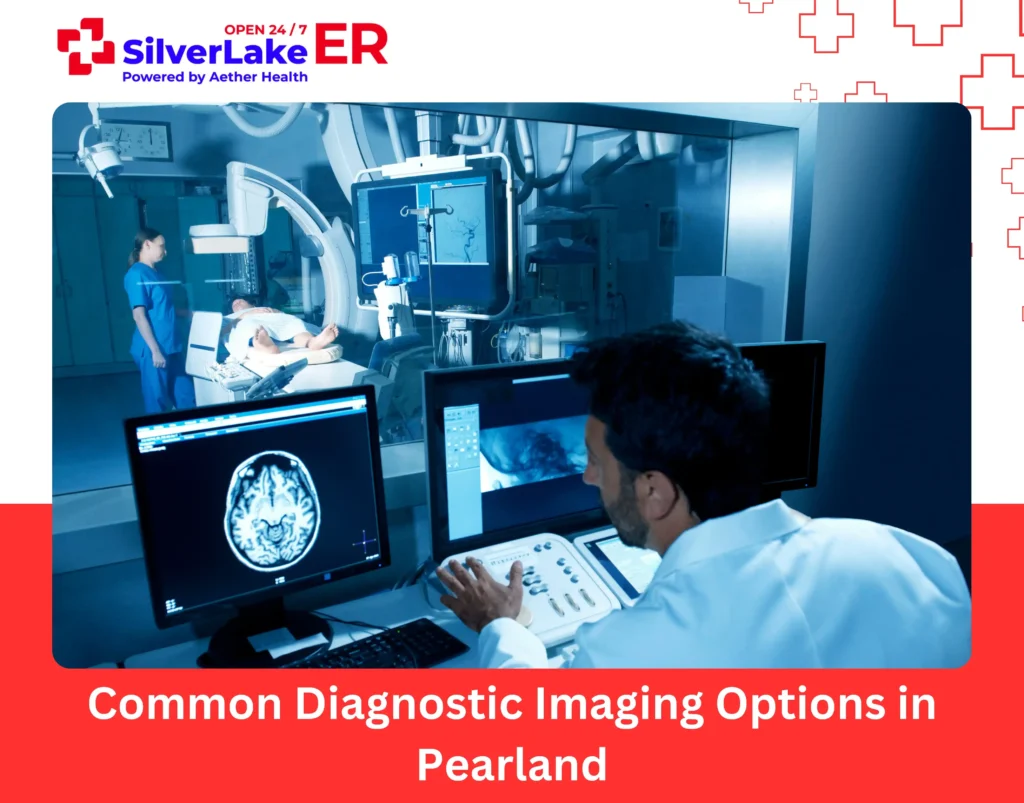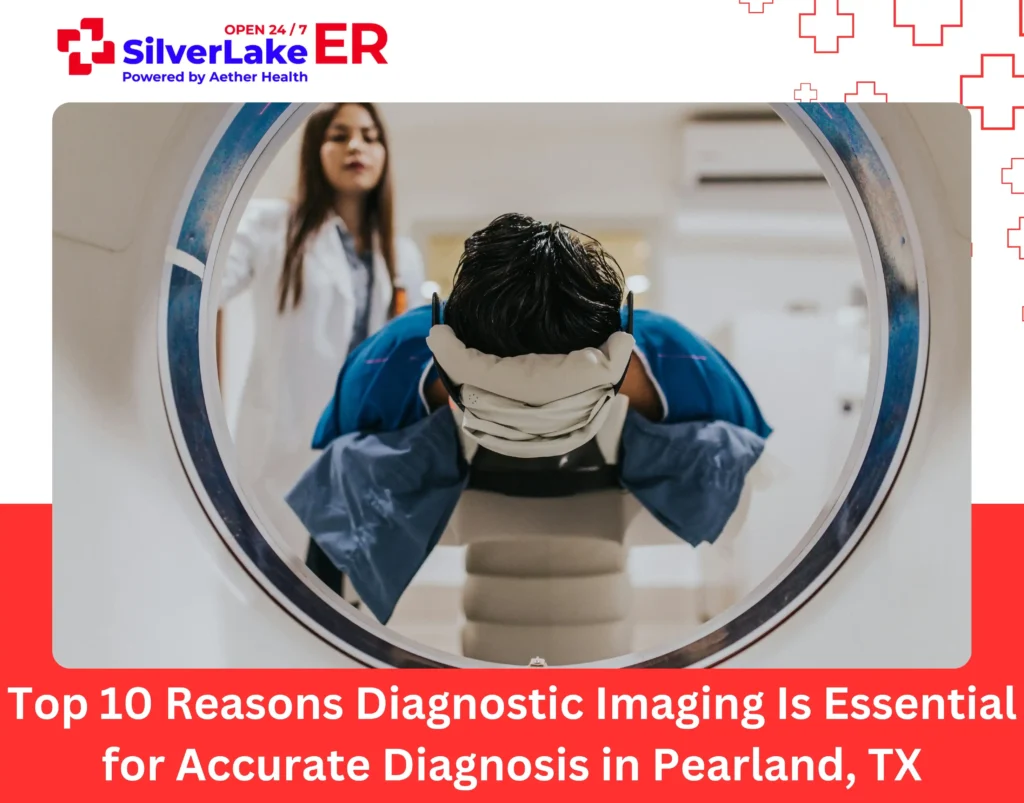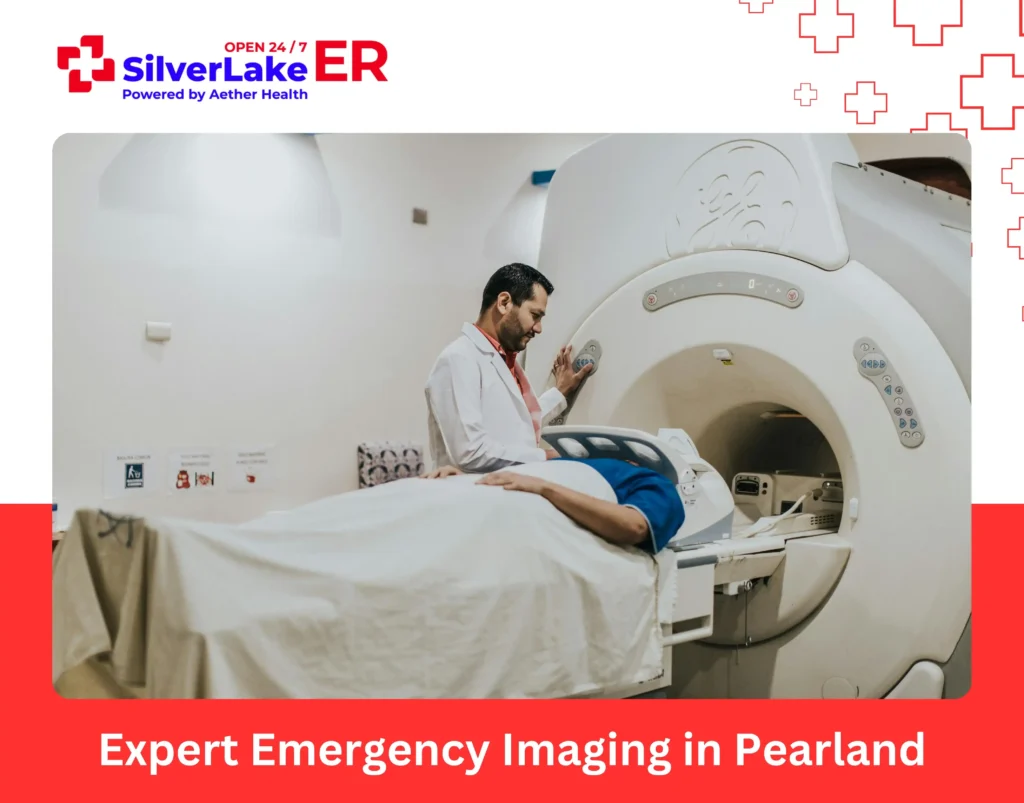Before diagnostic imaging, doctors had to determine your condition based on how you looked, what you told them, or what they could hear with a stethoscope. Of course, this often led to missed conditions and complications. Sometimes, they even had to perform risky exploratory surgeries just to understand what was happening inside your body.
Then came medical imaging. Doctors no longer had to rely on guesswork or perform exploratory surgeries. With Digital X-rays, CT scans, and MRIs, emergency physicians can instantly visualize fractures, internal bleeding, cancer, and other serious conditions.
At the Silverlake ER, we leverage these imaging tools to provide swift diagnosis and plan precise treatment. Let’s explore how our diagnostic imaging ensures accurate diagnosis for your health and well-being.
Common Diagnostic Imaging Options in Pearland

When you need quick answers about your condition, diagnostic imaging provides clear insights. At the Silverlake ER in Pearland, our comprehensive diagnostic imaging services evaluate everything from serious traumas to simple headaches. Common imaging tools include:
1. X-rays
X-rays are the oldest, most common, and quickest imaging tools. They come in various forms, including DEXA scans for bone density and mammography for breast screening. X-rays give a two-dimensional image of bones and joints, helping us identify:
- Broken bones and fractures
- Dislocations
- Chest problems like pneumonia or lung infections
- Foreign objects (if you accidentally swallow or get something stuck)
2. CT Scans
Computerized tomography (CT) scans are like 3D X-rays. They create detailed, cross-sectional images of the body and provide a lot of information in a short time. At ER in Pearland, we offer both contrast (with dye) and non-contrast CT scans, providing precise insights for conditions like:
- Internal bleeding
- Trauma injuries
- Strokes
- Blood clots
- Cancer
3. Ultrasounds
Our advanced ultrasound technology, including Doppler ultrasound, uses sound waves to create real-time images of soft tissues and organs. This safe and non-invasive tool helps us evaluate:
- Abdominal disorders (gallstones or appendicitis)
- Pelvic disorders (liver disease and kidney stones)
- Fluid buildup around organs
- Pregnancy complications
- Fetal development
4. MRI (Magnetic Resonance Imaging)
MRIs use magnetic fields and radio waves to produce highly detailed images of the inner body. They’re ideal for spotting issues in your brain, spine, or joints. Unlike X-rays, MRIs don’t use radiation but take longer to complete. They are particularly useful:
- Musculoskeletal disorders
- Brain and spinal injuries
- Brain Tumors
- Ligament and tendon tears
- Issues in the heart or blood vessels
Each imaging type serves different diagnostic needs. In emergency situations, CT scans and X-rays are usually the fastest and most effective tools for immediate diagnosis. Our doctors will recommend the most appropriate imaging method based on your symptoms and condition.
10 Reasons Diagnostic Imaging Is Essential for Accurate Diagnosis

Here’s why diagnostic imaging plays a crucial role in emergency care.
1. Find Hidden Injuries
Imaging helps us see inside your body and uncover hidden issues. For example, if you arrive with a sports injury, such as a twisted ankle from basketball, our digital X-rays can quickly determine if you’re dealing with a sprain or fracture. This helps us guide precise treatment from the start.
2. Detect Serious Conditions Early
Advanced imaging helps identify critical conditions before they become life-threatening. Our CT scans can reveal blockages in arteries and reveal concerning issues like appendicitis or internal bleeding. Similarly, an MRI identifies early signs of a stroke. Overall, diagnostic imaging in our emergency room helps us intervene immediately and improve survival rates.
3. Life Saver in Emergencies
In emergencies, every second counts. Diagnostic imaging gives us the information to make life-saving decisions. For instance, someone with head trauma may feel okay at first. But a CT scan shows if there’s internal bleeding or a concussion.
4. Pinpoint the Root Cause of Symptoms
Symptoms often have multiple possible causes. If someone comes to our ER with persistent chest pain, a combination of X-rays and CT scans can quickly distinguish between conditions like pneumonia, broken ribs, or other serious issues.
5. Diagnose Complex Conditions
Some diseases are tricky to diagnose. An MRI helps doctors see problems in your brain or spine that can be hard to find through just a physical exam.
6. Guide Treatment Plans
Imaging techniques help us determine which treatment approach will work best for you. For cases involving a tumor, an MRI can show exactly where it is, so doctors plan how to treat it.
7. Monitor Treatment Progress
After treatment begins, doctors use imaging to monitor your response to treatment. For example, a cancer patient needs scans to see if chemotherapy is shrinking the tumor. Similarly, someone with a broken bone may get follow-up X-rays to check if it’s healing properly.
8. Minimally Invasive & Less Painful Surgeries
Imaging guides doctors to perform smaller, less painful procedures instead of major surgeries. For example, a surgeon at Pearland ER may use an ultrasound to guide a needle to remove fluid from a cyst.
9. Brings Peace of Mind
The rapid results from our diagnostic imaging bring immediate clarity to your situation. Whether you’re dealing with unexplained pain or a traumatic injury, knowing exactly what’s wrong helps reduce anxiety and allows us to start appropriate treatment faster.
10. 24/7 Availability in Pearland
Our diagnostic imaging services in Pearland are available around the clock. With our skilled emergency physicians and advanced technology, you receive rapid and accurate imaging exactly when you need it, right here in your community.
Expert Emergency Imaging in Pearland

Diagnostic imaging is the backbone of modern medicine. It allows us to quickly identify and treat conditions that were once difficult to diagnose. At the Silverlake emergency room in Pearland, our advanced imaging capabilities mean you don’t have to wait for answers when experiencing concerning symptoms.
Don’t ignore warning signs like severe headaches, chest pain, abdominal pain, or serious injuries. Our emergency team is ready 24/7 with state-of-the-art X-rays, CT scans, and ultrasound technology to quickly diagnose your condition and begin appropriate treatment.
FAQs
1. What type of diagnostic imaging is right for my condition?
The type of imaging depends on your emergency symptoms. X-rays are best for potential broken bones and chest problems. CT scans are ideal for head injuries, severe pain, or potential internal bleeding. Ultrasound is used for abdominal pain, gallstones, or fluid accumulation. Our emergency physicians will determine the most appropriate imaging based on your specific symptoms.
2. Is diagnostic imaging safe?
Yes! While X-rays and CT scans use radiation, the benefits of quick and accurate diagnosis in emergency situations far outweigh any risks.



